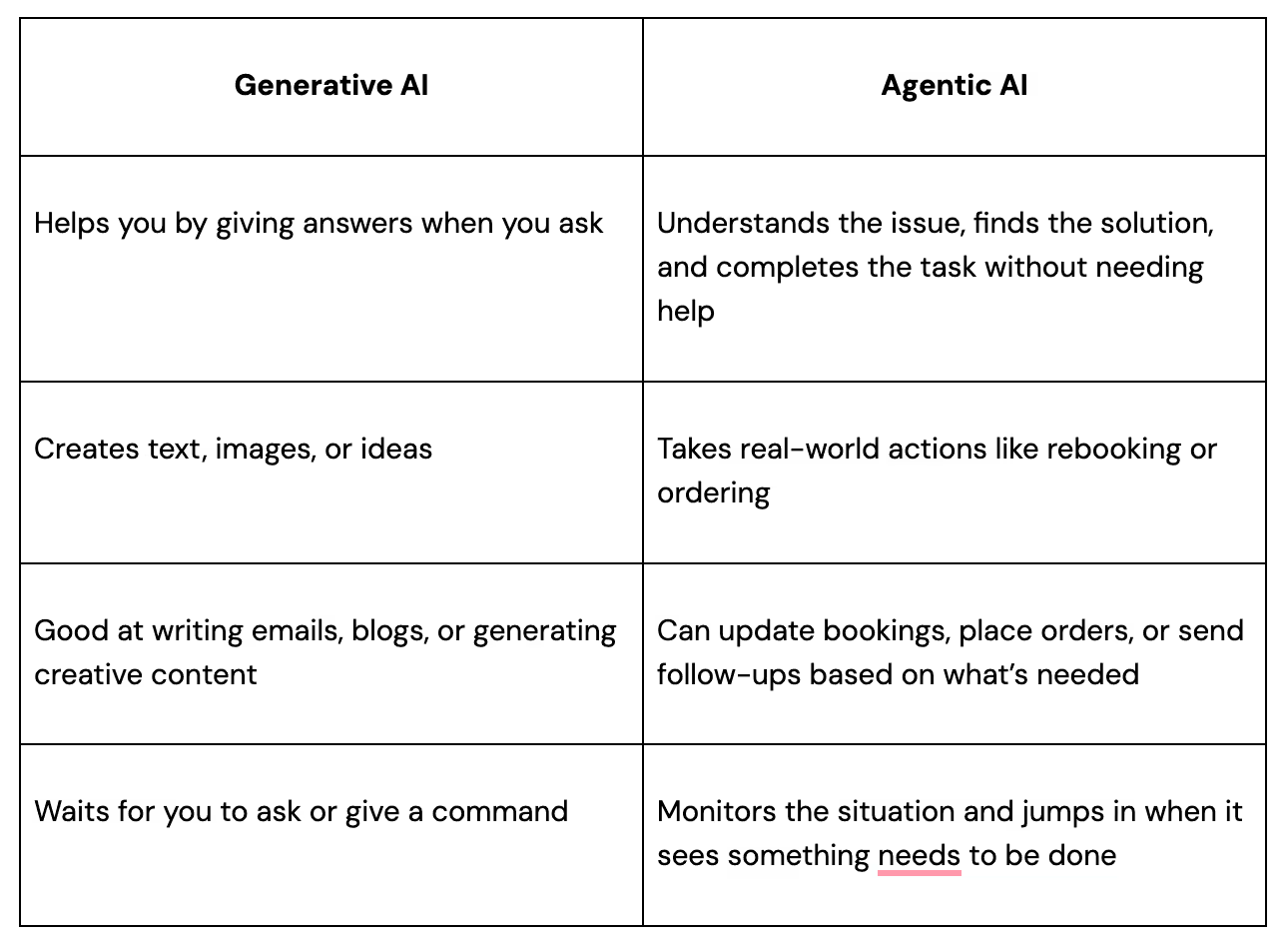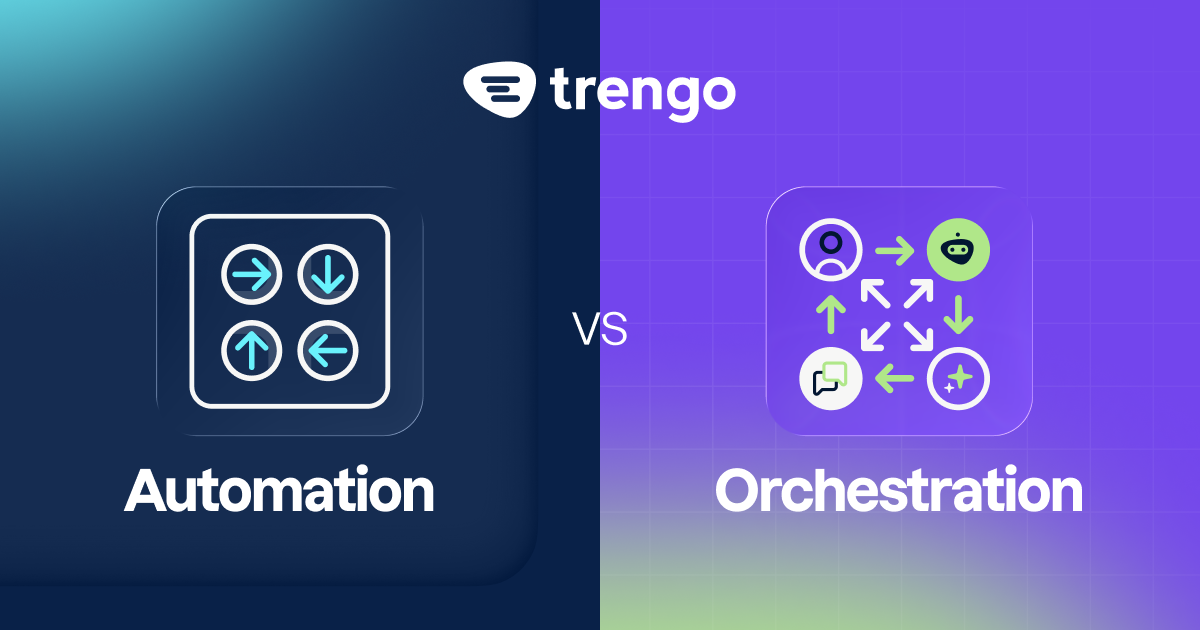Customer service is getting smarter every day. Companies are now using agentic AI in customer experience to help their customers faster and better than ever before. A recent HubSpot study found that 90% of consumers rate an immediate response as “very important” when they have a question, especially during urgent situations like order issues or billing problems.
Let’s say a customer tries to check out, but their payment fails. Instead of waiting in a support queue, agentic AI spots the failure in real time. It verifies the issue, applies a retry or alternate method, and sends a quick message confirming the update. No ticket, no wait, and no human needed.
Pretty cool, right? This is what makes agentic AI so powerful. It works like a digital agent, constantly monitoring for issues, making smart decisions, and taking action as soon as something goes wrong. The result is faster support, fewer delays, and happier customers.
In this blog, we’ll explore how agentic AI is speeding up customer service and improving satisfaction, reducing workload for teams, and setting a new standard for what great support looks like in 2025.
What is Agentic AI?
Agentic AI is a super-smart robot helper that can think and act on its own. Most AI tools today wait for a command. You ask a question, and they give you an answer. Agentic AI changes that. It can plan, decide, and act on its own using information from different sources.
For example, if you run a business, agentic AI can watch your inventory. When stock is low, it checks with your supplier, looks for better prices, and places an order that fits your budget. You don’t have to do anything.
If your team is travelling for a meeting, the AI can book flights and hotels. If the meeting time changes, it updates the bookings and sends your team a new schedule with the best available options.
Inside the company, agentic AI can track how teams are doing. If customer reviews start to drop, the AI finds the reason, picks the right team members to help, and books training sessions to fix the issue.
Agentic AI does all of this in the background. It saves time, reduces mistakes, and helps your business run more smoothly.
Agentic vs Generative AI: How Agentic AI is different from Generative AI
You may already know about generative AI. That’s the kind of AI that helps you write emails, answer questions, or create designs. Tools like ChatGPT are good examples. Generative AI is helpful, but it only works when you tell it what to do.
Agentic AI is more powerful because it can act on its own. It uses the same skills as generative AI but also solves problems by making decisions and completing tasks. It doesn't just reply—it gets things done.
Let’s look at a simple comparison:

For example, if a customer gets the wrong item, generative AI might help you write an apology message. Agentic AI goes further. It can check the order history, process a return, send a replacement, and update the customer automatically.
So, if you want faster service, fewer errors, and happier customers, agentic AI can help you get there.
Advantages of Agentic AI
Using agentic AI for customer service brings many benefits that make both customers and businesses happy.
Automated quality assurance
In traditional customer service, quality can vary from one agent to another. A good experience depends heavily on the mood, energy, and attention of the person handling the request. Mistakes happen, rules may be skipped, and not every customer gets the same level of care.
Agentic AI changes this completely. It follows pre-set service standards every time, without exceptions. It reviews conversations in real time and ensures that each customer is getting clear, helpful, and polite responses. If it detects a problem, such as a long delay, missing information, or incorrect guidance, it can step in to fix the issue or alert a supervisor immediately. This helps businesses maintain high-quality service at all times, across every channel and every interaction.
Smarter self-service experiences
Most customers today prefer to solve simple problems on their own rather than waiting to speak with an agent. However, many self-service tools, like static FAQ pages or rigid chatbot scripts, still leave users frustrated. Agentic AI provides a better experience by guiding users through solutions in a more conversational and personalised way.
Customers can explain their problem in plain language, and the AI will respond with accurate, step-by-step instructions tailored to that situation. It understands intent, follows up with the right questions, and adapts its responses just like a real support agent would. This makes self-service faster, easier, and more enjoyable, leading to higher resolution rates and lower support volume.
Unified support across all channels
Customers no longer stick to one platform when they reach out for help. They might start a conversation through a live chat on your website, follow up later via email, and eventually call your support line. With traditional systems, this results in lost context, repeated questions, and frustrated customers.
Agentic AI is built to manage conversations across multiple channels such as WhatsApp, Facebook, email, voice, and SMS. It keeps track of each customer’s journey, remembers past interactions, and uses that context to continue the conversation smoothly. This allows customers to switch between channels without having to repeat their issue, and it helps businesses provide a more connected and professional support experience.
Self-learning and continuous improvement
Training human agents takes time, resources, and ongoing supervision. Even then, performance can vary based on experience or motivation. Agentic AI, on the other hand, improves automatically with every conversation. It uses natural language understanding to learn what kinds of responses work best. It analyses successful interactions, learns from customer feedback, and adapts to new scenarios without the need for retraining.
Additionally, the AI can be trained on internal knowledge bases and can study how top-performing human agents solve problems. Over time, it adopts those best practices and becomes even more effective. This leads to better support outcomes and fewer mistakes without the cost and effort of traditional training.
Personalised customer experiences
Every customer expects to be treated as an individual, not just another ticket in a queue. Agentic AI can deliver highly personalised experiences by using real-time data and past interactions. It remembers a customer’s purchase history, preferences, and support needs. For example, if a customer frequently buys a specific product, the AI can suggest a reorder or recommend similar items.
If someone has a history of high-value purchases or is part of a loyalty program, the AI can prioritise their requests and offer tailored responses. This kind of intelligent personalisation increases customer satisfaction and helps businesses build stronger relationships with their audience.
Smarter, faster call routing
When customers need to speak to a human agent, it is essential that they are connected to the right person quickly. In many call centres, customers are transferred multiple times, asked to repeat their issue, and left waiting in long queues. Agentic AI makes this process more efficient.
It listens to the customer's question, identifies the issue using intent analysis, and uses internal data to match the request with the best available agent based on skills, language, or department. This ensures customers get the right help faster and only have to explain their issue once. It reduces frustration, shortens wait times, and improves first-contact resolution rates.
Agentic AI’s top use cases
Let's look at real examples of how agentic AI is being used to help customers in amazing ways.
Use case 1: Autonomous customer issue resolution
Imagine you ordered a pizza for delivery, but it never showed up. With traditional customer service, you'd have to call the restaurant, wait on hold, explain the problem, and then wait for someone to fix it.
With agentic AI, here's what happens instead:
- The AI notices your order is very late
- It checks with the delivery system and sees that the driver had an accident
- It automatically cancels your order and processes a full refund
- It sends you a message explaining what happened and offering a discount for next time
- All of this happens before you even realise there's a problem
This kind of proactive problem-solving makes customers feel like the company really cares about them.
Use case 2: Goal-based AI agents
Instead of just answering questions, agentic AI can understand what customers are trying to achieve and help them reach their goals.
For example, if a customer says "I need to cancel my hotel booking and book something for next weekend instead," the AI understands this is one big goal with several steps:
- Cancel the current booking
- Process any refunds
- Find available hotels for next weekend
- Make a new reservation
- Send confirmation details
The AI handles all these steps automatically, making it super easy for the customer.
Use case 3: AI agents monitoring omnichannel inboxes
Modern businesses get messages from customers through many different channels - email, chat, social media, phone calls, and more. Agentic AI can watch all these conversations at once and understand what's happening.
The AI can:
- Spot urgent problems and handle them immediately
- Notice when customers are getting frustrated and step in to help
- Identify which conversations need human attention
- Automatically sort and organise messages
- Send conversations to the right team members
This means nothing falls through the cracks and customers always get timely responses.
Use Case 4: Proactive Engagement
One of the coolest things about agentic AI is that it can start conversations with customers when it notices they might need help.
For example:
- If someone puts items in their online shopping cart but doesn't buy them, the AI might send a helpful message with a small discount
- If a customer keeps visiting the same help page, the AI might offer to chat and provide personalised assistance
- If someone's subscription is about to expire, the AI can reach out with renewal options
This proactive approach makes customers feel cared for and often solves problems before they become bigger issues.
Top 3 Agentic AI platforms
Let’s take a look at the top platforms that bring agentic AI to life. These tools help your team work smarter and make customer service faster and easier.
1. Trengo - The Complete Agentic AI Solution
Trengo is one of the most advanced platforms offering agentic AI for customer service. It helps businesses automate repetitive tasks, respond to customers instantly, and manage conversations across all channels in one place. With a strong focus on usability and performance, Trengo gives companies the tools to deliver smarter, faster, and more consistent support at scale.
Smart automation that handles 80% of repetitive work
Trengo’s AI tools are designed to reduce pressure on human agents. The platform can automate over 80% of repetitive customer conversations, allowing support teams to focus on more complex cases that require a human touch. This means shorter wait times for customers, faster resolutions, and a better overall experience.
Two core Agentic AI tools: HelpMate and Journeys
Trengo offers two key AI products that work together to create a full agentic support system:
- AI HelpMate
This tool automates replies to common customer questions across channels like WhatsApp, email, live chat, and Instagram. HelpMate also provides real-time reply suggestions to agents, helping them answer faster and more accurately. It pulls knowledge from your help docs, past conversations, and FAQs, so it always has the latest information. - AI Journeys
This tool builds automated conversation flows that can greet customers, ask follow-up questions, route chats to the right teams, and take action like booking, updating orders, or gathering form data. It supports over 70 languages and uses smart logic to create step-by-step support paths that feel natural and personal.
No-code setup with drag-and-drop flows
One of Trengo’s biggest strengths is how easy it is to set up and use. Businesses don’t need developers or technical skills to build automated conversations. The platform includes a drag-and-drop flow builder, where you can design custom workflows, choose responses, and trigger actions based on customer behaviour. You can also train the AI using your existing help content, like articles, PDFs, or documents.
Omnichannel Support in One Shared Inbox
Trengo brings all customer conversations together in a single inbox. That includes:
- Facebook Messenger
- SMS
- Website chat
- Google Business Messages
Agents can see everything in one place, and AI can respond automatically no matter where the conversation started. This unified view helps teams stay organised, reduce response times, and avoid missing messages.
Real-world business impact
Many companies using Trengo’s AI tools have seen major improvements:
- FerryScanner reduced human handovers by 50% after using AI Journeys to automate booking support.
- Surfawhile doubled its support team’s efficiency, thanks to Flowbots handling basic travel inquiries.
- Bas World saw a 70% increase in qualified leads by using AI Journeys to guide website visitors to the right service options.
- Billink used Trengo to automate 80% of its incoming customer messages, cutting down agent workload and boosting response speed.
Trengo gives your business everything it needs to deliver modern, AI-powered customer service. With its agentic AI features, no-code design, and real-time problem-solving, it helps companies move from reactive support to proactive, intelligent service on every channel, 24/7.
2. Zendesk - AI-Powered Customer Support
Zendesk has been in the customer service game for a long time, and they've added powerful AI features to their platform. Their AI can understand customer emotions, predict what customers need, and automatically suggest solutions.
The platform is good at handling tickets and organising customer requests. Their AI can look at a customer's message and automatically categorise it, assign it to the right team, and even suggest responses. While not as advanced as Trengo in autonomous problem-solving, Zendesk is solid for businesses that want traditional ticketing with AI assistance.
3. Intercom - Conversational AI Platform
Intercom focuses on making conversations between businesses and customers feel natural and helpful. Their AI can have real conversations with customers and understand context from previous interactions.
Their Resolution Bot can handle many common customer questions automatically, and their AI can hand over conversations to human agents when needed. Intercom is particularly good for businesses that want to blend AI and human support seamlessly.
Final Words
Agentic AI in customer experience is not just a fancy new technology. It's the future of how businesses will help their customers. This smart technology can solve problems on its own, learn from every interaction, and provide personalised help that makes customers feel valued.
The benefits are clear: customers get faster, better service, and businesses can help more people with less effort. As more companies adopt agentic AI, the ones that don't will be left behind.
For businesses looking to get started with agentic AI, platforms like Trengo make it easy to begin. You don't need to be a tech expert to set up AI agents that can transform your customer service.
The future of customer service is here, and it's powered by agentic AI. Companies that embrace this technology now will build stronger relationships with their customers and grow their business faster than ever before.
Ready to see how agentic AI can transform your customer service? Get a free demo of Trengo's AI platform and discover how you can automate up to 80% of your customer conversations while keeping the personal touch your customers love.
Frequently Asked Questions (FAQs)
How can agentic AI improve customer service automation?
Agentic AI enhances customer service automation by not only responding to queries but also taking proactive actions on behalf of customers. Unlike traditional bots, agentic AI can understand context, make decisions, and complete multi-step tasks, such as processing refunds, updating bookings, or escalating complex issues, without human intervention. Platforms like Trengo integrate agentic AI to automate repetitive tasks, personalise responses, and ensure customers receive timely, accurate support across all channels.
How is agentic AI different from chatbots like ChatGPT or rule-based bots?
Agentic AI differs from standard chatbots and rule-based bots in its autonomy and adaptability. While rule-based bots follow set scripts and ChatGPT-style bots generate responses based on prompts, agentic AI can independently analyse situations, learn from interactions, and initiate actions to resolve customer needs. This means agentic AI can handle more complex scenarios, adapt to changing customer intent, and deliver a more seamless and human-like experience.
What platforms offer agentic AI tools for CX teams?
Several leading platforms provide agentic AI capabilities for customer experience teams, including Trengo. Trengo’s customer engagement platform leverages agentic AI to automate conversations, assign tasks, and manage multi-channel interactions in one unified dashboard. Other platforms in the market are also evolving towards agentic AI, but Trengo stands out for its European focus, ease of integration, and robust automation features.
Can agentic AI personalise customer journeys in real time?
Yes, agentic AI can personalise customer journeys in real time by analysing customer data, behaviour, and preferences across touchpoints. Using platforms like Trengo, agentic AI can tailor responses, recommend products, and trigger relevant workflows as the conversation unfolds, ensuring each customer receives a unique, context-aware experience.
What industries are already using agentic AI in customer service?
Agentic AI is being adopted across various sectors, including retail, travel, hospitality, financial services, and e-commerce. Businesses use agentic AI to automate support, drive engagement, and deliver consistent service at scale. For example, real estate companies like Flat.mx have used Trengo to automate WhatsApp templates and offer highly personalised service, resulting in faster response times and higher customer satisfaction.
Can agentic AI reduce average response and resolution times in support?
Absolutely. By automating routine queries, triaging requests, and even resolving more complex issues without human input, agentic AI significantly reduces both response and resolution times. With Trengo, businesses have seen measurable improvements in customer satisfaction and operational efficiency as agentic AI handles repetitive tasks, freeing human agents to focus on high-value interactions.
How does agentic AI ensure consistent tone and brand voice in conversations?
Agentic AI platforms like Trengo allow you to define and manage your brand’s tone of voice centrally. The AI is trained to follow brand guidelines, word choice, and communication style—whether friendly, professional, or playful—across all channels. This consistency not only reinforces your brand identity but also builds trust and loyalty among customers. Trengo’s multichannel approach ensures every customer receives on-brand, high-quality service, regardless of which channel they use.




.png)











